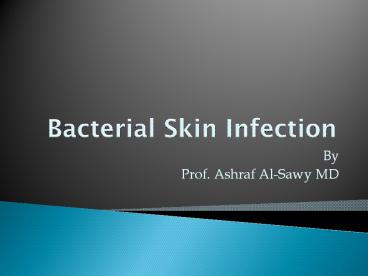Bacterial Skin Infection - PowerPoint PPT Presentation
1 / 43
Title:
Bacterial Skin Infection
Description:
Skin dis. provoked or influenced by strepto. inf.: psoriasis especially guttate forms. Acute contagious skin infection caused mostly by staph. Aureus and strept. – PowerPoint PPT presentation
Number of Views:1272
Avg rating:5.0/5.0
Title: Bacterial Skin Infection
1
Bacterial Skin Infection
- By
- Prof. Ashraf Al-Sawy MD
2
(No Transcript)
3
Staph. Aureus Infection
- Direct infection of skin impetigo, ecthyma,
folliculitis, furunculosis, carbuncle, sycosis. - Secondary infection eczema, infestations,
ulcers, etc. - Effect of bacterial toxin staph.-associated
scalded skin syndrome (SSSS), toxic shock
syndrome.
4
strepto. Infection (GAS)(gp A streptococci)
- Direct inf. of skin or subcut. tissue Impetigo,
ecthyma, cellulitis, vulvovaginitis, perianal
inf., strepto. ulcers, blistering distal
dactylitis, necrotizing fasciitis. - 2ry inf. eczema, infestations, ulcers, etc.
5
- Tissue damage from circulating toxin scarlet
fever, toxic shock-like syndrome. - Skin lesions attributed to allergic
hyper-sensitivity to strepto. antigens erythema
nodosum, vasculitis. - Skin dis. provoked or influenced by strepto.
inf. psoriasis especially guttate forms.
6
Impetigo
7
- Acute contagious skin infection caused mostly by
staph. Aureus and strept. - Affects children mainly esp. in summer times.
8
Clinical types
- 1- Non-bullous impetigo
- Caused by staph., strept. or both organisms.
- 2- Bullous impetigo
- Caused by staph aureus.
9
Non-bullous Impetigo
- Staph. aureus or gp A stretp. (GAS) or both
mixed infections. - May arise as 1ry inf. or as 2ry inf. of
pre-existing dermatoses, e.g. pediculosis,
scabies eczemas. - An intact st. corneum is probably the most
important defense against invasion of pathogenic
bacteria.
10
- A thin-walled vesicle on erythematous base, that
soon ruptures the exuding serum dries to form
yellowish-brown (honey-color) crusts that dry
separate leaving erythema which fades without
scarring. - Regional adenitis with fever may occur in severe
cases.
11
(No Transcript)
12
- Sites Exposed parts eg. face extremities.
Scalp (in pediculosis). Any part could be
affected except palms soles. - Complications Post-streptococcal acute
glomerulo-nephritis AGN especially in cases due
to strepto. pyogenes M. type 49.
13
Varities
- Circinate impetigo with peripheral extension of
lesion healing in the center.
14
- Crusted impetigo
- on the scalp complicating pediculosis. Occipital
cervical LNs are usually enlarged tender.
15
- Ecthyma (ulcerative impetigo) adherent crusts,
beneath which purulent irregular ulcers occur.
Healing occurs after few wks, with scarring.
16
- Site more on distal extremities (thighs legs).
17
Bullous Impetigo
- Age all ages, but commoner in childhood
newborn (impetigo neonatorum). - Site face is often affected, but the lesions may
occur anywhere, including palms soles.
18
- The bullae are less rapidly ruptured (persist for
2-3 days) become much larger. The contents are
at first clear, later cloudy. After rupture,
thin, brownish crusts are formed.
19
Treatment of impetigo
- Treatment of predisposing causes e.g.
pediculosis scabies. - Remove the crusts by olive oil or hydrogen
peroxide. - Topical antibiotic e.g. tetracycline,
bacitracin, gentamycin, mupiracin (Bactroban),
Fusidic acid (Fucidin).
20
- Systemic antibiotics are indicated especially in
the presence of fever or lymphadenopathy, in
extensive infections involving scalp, ears,
eyelids or if a nephritogenic strain is
suspected, e.g. penicillin, erythromycin
cloxacillin. - Azithromycin (Zithromax) 2 caps 500 mg daily
for 3 days in adults. - In erythromycin-resistant S. aureus amoxicillin
clavulanic a. (Augmentin) 25 mg/kg/day.
21
Folliculitis
22
- inflammatory disease of the hair follicles, which
may be infectious or non-infectious.
23
- Superficial Folliculitis
- (Bockharts Impetigo)
24
- a dome-shaped pustule at the orifice of a hair
follicle that heals within 7-10 days.
25
- Caused by staph aureus and affects mainly
extremities and scalp. - Topical steroids are a common predisposing
factor.
26
- Sychosis Vulgaris
27
- Recurrent red follicular papules or pustules
centered on a hair, usually remain discrete over
the beard or upper lip, but may coalesce to
produce raised plaques studded with pustules. - DD pseudofolliculitis of the beard, T. barae.
28
- Pseudofolliculitis
29
- from penetration into the skin of sharp tips of
shaved hairs.
30
(No Transcript)
31
Frunculosis (boils)
32
- It is a staphylococcal infection similar to, but
deeper than folliculitis invades the deep parts
of the hair folliculitis. - Occasionally several closely grouped boils will
combine to form a carbuncle. The carbuncle
usually occurs in diabetic cases. The site of
election is the back of the neck.
33
Cellulitis Erysipelas
34
- Cellulitis is an infection of subcutaneous
tissues. - Ersipelas Its due to infection of the dermis
upper subcutaneous tissue by gp A streptococci.
The organism reaches the dermis through a wound
or small abrasion. It is regarded as a
superficial dermal form of cut. cellulitis.
35
- Erythema, heat, swelling and pain or tenderness.
- Fever and malaise which is more severe in
erysipelas. - In erysipelas blistering and hemorrhage.
- Lymphangitis and lymphadenopathy are frequent.
36
- Edge of the lesion well demarcated and raised in
erysipelas and diffuse in cellulitis.
37
Complications
- Recurrences may lead to lymphedema.
- Subcutaneous abscess.
- Septicemia.
- Nephritis.
38
Treatment
- Systemic antibiotics, especially penicillin, e.g.
benzyl penicillin 600-1200 mg IV/6 hrs or
cephalosporines. - Rest, analgesics.
39
Skin diseases related to coryneform bacteria
- Erythrasma
40
- It is mild, chronic, localized superficial
infection of skin by Coryn. Minutissimum. - Clinically sharply-defined but irregular brown,
scaly patches
41
- usually localized to groins, axillae, toe clefts
or may cover extensive areas of trunk limbs.
Obesity DM may coexist. - Coral red fluorescence under woods light.
42
Treatment
- Topical treatment with azole antifungal agents
for 2 weeks or topical fucidin. - Erythromycin orally.
43
(No Transcript)































